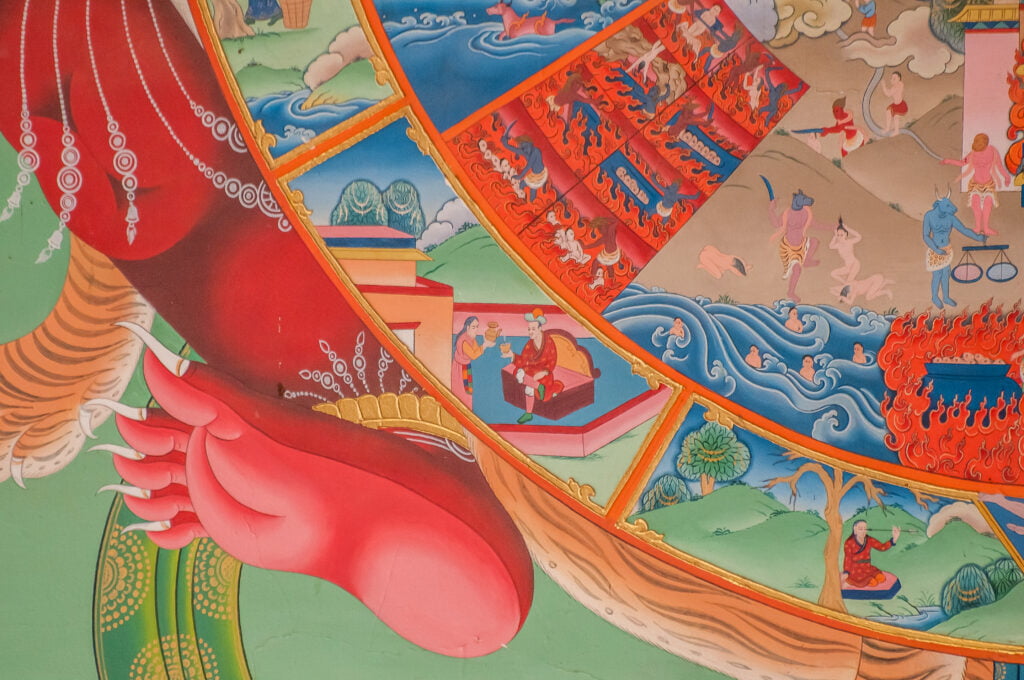Suffering is the first of the four truths of the noble ones taught by the Buddha after his awakening during the first turning of the Wheel of Dharma in Sarnath. The Buddha taught that suffering must be known, or understood. As the Buddha explained, the term “suffering” includes experiences that could translate as stress, unease, dissatisfaction, pain, discomfort, or unhappiness. Contrary to some misinterpretations, the Buddha did not say there is no happiness. However, his insight was that all temporary experiences eventually come to an end. As sentient beings are thus never permanently satisfied, there is suffering.
Jamgön Kongtrül Lodrö Thayé in The Treasury of Knowledge defined the essence of the truth of suffering as, “the continuity of the aggregates produced by previous karma and mental afflictions.”1The Treasury of Knowledge, Book Six, Part Three: Frameworks of Buddhist Philosophy, A Systematic Presentation of the Cause-Based Philosophical Vehicles, by Jamgön Kongtrül Lodrö Thayé, trans. by Elizabeth Callahan. Snow Lion Publications, NY, 2007. The five aggregates, or skandhas, are the mental and physical elements that make up the experience of an individual. Thus this definition expresses the notion that the psycho-physical package embodied by a sentient being has been conditioned by prior mental and physical actions. As long as that conditioning remains, suffering will occur.
In the Abhidharma and other texts, suffering can be divided into as many as eight different categories. However, these can be subsumed into three major classifications.
The Three Sufferings
- Suffering of Suffering
- Suffering of Change
- All-pervasive Suffering of Being Conditioned
1. The Suffering of Suffering
The suffering of suffering is the grossest level. This includes the suffering, unease, and discomfort associated with the four stages of existence: birth, growing old, sickness, and death. The other suffering of suffering is that of encountering unpleasant situations. All of these situations bring obvious pain.
2. The Suffering of Change
The suffering of change manifests when one cannot obtain or keep what one desires. In one situation, one has a longing for something but can’t achieve the goal. One tries but fails, which results in distress. Alternatively, one might experience temporary happiness or pleasure based on some external condition. Then something changes. Change is inevitable, and pleasure turns to sorrow or boredom.
3. The All-Pervasive Suffering of Being Conditioned
The all-pervasive suffering of being conditioned marks the difference between observable suffering and the truth that is apparent to noble beings. As Jamgön Kongtrül noted, the first 2 categories are recognizable by ordinary individuals and thus belong to conventional truth. He quoted Vasubandhu’s Commentary on the Treasury of Abhidharma (Abhidharmakosha-bhāsya) which explains the subtle nature of all-pervasive suffering:
Immature beings are like the palm of the hand:
The Treasury of Knowledge, Book Six, Part Three: Frameworks of Buddhist Philosophy, A Systematic Presentation of the Cause-Based Philosophical Vehicles, by Jamgön Kongtrül Lodrö Thayé, trans. by Elizabeth Callahan. Snow Lion Publications, NY, 2007.
They do not recognize the hair of the suffering of conditioned existence.
Noble ones are like the eye:
They are greatly disturbed by that hair.
Because this suffering is only observable by noble beings, even though it is not truly established, it is considered to be ultimate reality. The Buddha described this situation to his brother-in-law Nanda, in terms that are quite easy to understand in the sutra called “The Teaching to Venerable Nanda on Entry into the Womb”.
Nanda, in brief, as for this body consisting of the five upādānaskandhas (appropriated skandhas), there are no activities of moving, standing, sitting, or lying down that are not suffering. If one walks for a long time without even a moment’s rest, suffering will arise. Standing, sitting, and lying down, if done for a long time, will all be suffering. If, after walking for a long time, there is a moment’s rest, even though a notion of pleasure is produced, this is not really pleasure. If, after standing for a long time, one sits for a moment, or if, after sitting for a long time, one lies down for a moment, a false notion of pleasure is produced; however, since this is not really pleasure, this body consisting of the five upādānaskandhas should therefore be known to be wholly suffering.
Āryāyuṣmannandagarbhāvakrāntinirdeśa, The Noble Great Vehicle Sūtra “The Teaching to Venerable Nanda on Entry into the Womb”, 1.67.
In this sutra, the Buddha led Nanda through a detailed analysis of human suffering. In this analytical process, understanding that all experiences are impermanent, the young man was able to resolve confidently the lack of a personal self. And with that realization, according to the sutra:
After the Bhagavān spoke this Dharma discourse, Nanda, freed from dust and defilement, obtained the pure Dharma eye. The five hundred monks, detached from phenomena, their defilements extinguished, had their minds liberated.
Āryāyuṣmannandagarbhāvakrāntinirdeśa, The Noble Great Vehicle Sūtra “The Teaching to Venerable Nanda on Entry into the Womb”, 1.78.
In a similar way, Buddhist teachers in all traditions emphasize the need for careful contemplation and analysis of suffering. Through coming to see the fact of suffering, liberation becomes possible.


